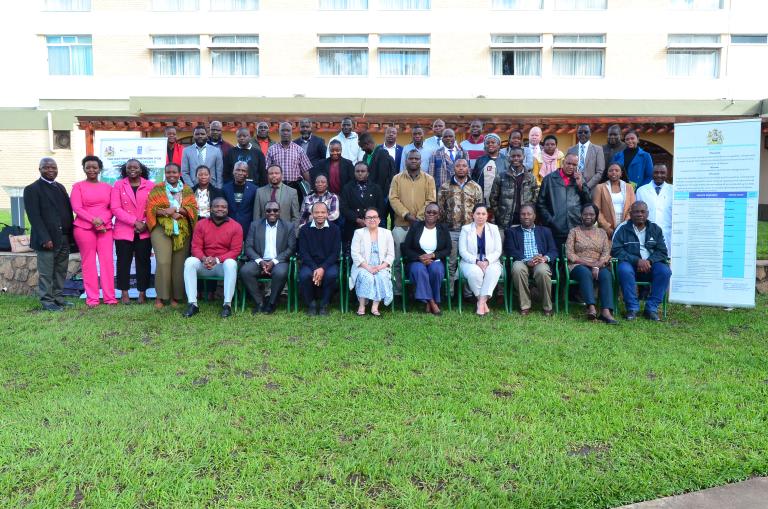Malawi is taking bold steps to strengthen its climate resilience and early warning systems, combining national leadership with community-led action, and innovation and Artificial Intelligence with local knowledge and expertise.
Recurring climate shocks could potentially decrease Malawi's GDP by as much as 16% by 2050 if immediate action is not taken, according to the Principal Secretary for the Ministry of Environment and Climate Change (DCCMS), Yusuf Mkungula.
"Strengthening coordination and partnerships is essential for delivering effective and sustainable early warning and climate services." Dr. Mkungula told the opening session of a major two-day partner coordination meeting
The Climate Risk and Early Warning Systems (CREWS) Malawi Partner Coordination and Stocktaking Meeting, organized by WMO in collaboration with the World Bank and project implementing partners, brought together over 100 representatives from government ministries and departments, international organizations, development agencies, academia, NGOs, and civil society groups
Field visits to communities in two districts, Zomba and Mzuzu, assessed the impact of CREWS investments at the local level to ensure that the people most in need receive timely early warning information, and benefit from improved last-mile delivery.
Pivotal moment
Malawi is at a pivotal moment in its climate initiatives, with the Meteorological Bill under review, the DCCMS Strategic Plan nearing completion, a new Climate Policy in development, and the operationalization of the Disaster Risk Management Act .
These efforts align with Malawi's goal to achieve Early Warnings for All by 2027, ensuring that every citizen - regardless of their location or circumstances - has access to timely and actionable information that can save lives and protect livelihoods.
At the two-day session, WMO Representative, Joshua Ngaina, highlighted progress within Malawi's Department of Climate Change and Meteorological Services (DCCMS), including the operationalization of ENACTS Maprooms, the deployment of WIS2Box , and the development of a gender and child-sensitive National Framework for Climate and Water Services (NFWCS), as well as implementation of gender-responsive, community-based early warning systems.
For the World Bank, Catalina Marulanda underscored the importance of supporting DCCMS in developing its Strategic Plan (2025-2030), which will integrate inclusive approaches to early warning services.

Power of Partnerships
Malawi faces major infrastructure gaps, with only 28 out of 100 weather stations currently fully operational. It is estimated that $63 million will be needed to implement the National Framework for Water and Climate Services, according to DCCMS director, Lucy Mtilatila.
She shared findings from a preliminary cost-benefit analysis, which indicated that every dollar invested in meteorological services could yield up to $14 in benefits.
Despite the challenges, Malawi is making strides in forecast accuracy and user uptake.
The bilingual weather app, Zanyengo , is set to enhance public access to climate information, drawing on strengthened observation networks, ICT platforms such as the Climate and Weather Information System, and localized dissemination through community radios, SMS, and village committees.
"DCCMS has achieved a significant milestone on social media, with its official Facebook page now having over 50,000 followers and an aim to reach 500,000 within the next five years. This reflects the growing public interest in receiving timely weather information." Dr. Mtilatila noted
Technical Innovation and Community Action
A new Artificial Intelligence pilot project , also funded by the CREWS, aims to utilize a state-of-the-art AI-based Weather Prediction (AI-WP) system to improve the accuracy, timeliness, and accessibility of weather predictions.
Technological innovation is combined with community action.
The field mission to Mzuzu and Zomba showcased tangible results on the ground.
In Mzuzu, communities applied the risk awareness knowledge gained through the project to construct drainage systems that now prevent flooding in their homes. Disaster Risk Management Committees (DRMCs) are actively implementing Standard Operating Procedures, risk maps, and contingency plans developed with support from WMO and the Malawi Red Cross.
These committees have also received training in search and rescue operations and been equipped with essential items such as PPE, torches, and other emergency tools.
As a result of this support, the number of flood-related deaths has decreased, and there is a growing understanding of inclusive risk governance, with a particular focus on vulnerable groups. The project has also fostered a culture of awareness that enables communities to make proactive decisions.
In both Mzuzu and Zomba, block leaders are playing a pivotal role in disseminating last-mile warnings, demonstrating strong, well-coordinated structures from the district level to individual households. Using a combination of word-of-mouth communication and instant messaging, they ensure the timely delivery of alerts, including to people with disabilities, women and children.
Prince Ngulebe, a Disaster Risk Management Committee member in Mzuzu, explained:
"When the city council sends warnings, we receive them on WhatsApp and spread them to every household. Everyone knows who to call and where to go."
Mr Talipu, a village elder in Zomba, said:
"Thanks to CREWS support, we now understand that we live in a dangerous area and know what to do in case of a disaster. We are better prepared and can help protect ourselves and members of our community."






